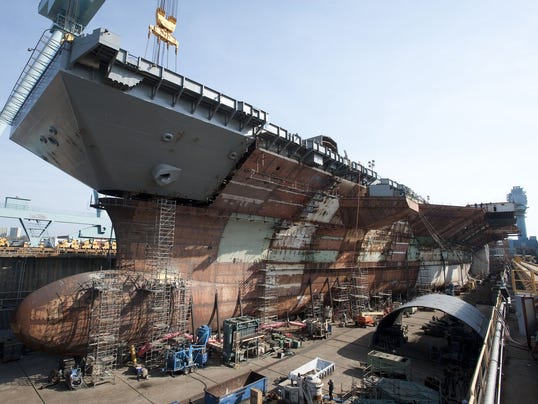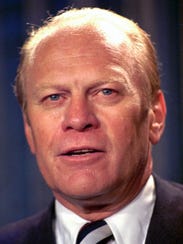Results 1 to 1 of 1
Thread Information
Users Browsing this Thread
There are currently 1 users browsing this thread. (0 members and 1 guests)
-
11-08-2013, 12:29 AM #1
Navy set to christen new carrier USS Gerald R. Ford
Navy set to christen new carrier USS Gerald R. Ford
Todd Spangler, Detroit Free Press10:28 p.m. EST November 7, 2013
The Ford will usher in the Navy's first new class of carriers in 40 years.

(Photo: Detroit Free Press, courtesy of John Whalen)
STORY HIGHLIGHTS
- Carrier won't be ready for service until 2016
- Ford costs $12.5 billion, $2 billion more than anticipated
- President Ford died in December 2006
WASHINGTON -- With the smashing of a bottle of sparkling wine against her hull, America's newest aircraft carrier expected to help define naval technology and readiness for a generation will be christened Saturday in honor of Gerald R. Ford, the only Michigan man to serve as the nation's commander-in-chief.
It will be the first new class of carriers in 40 years, and both the ship and its class are named for the late president, who served on the aircraft carrier USS Monterey during World War II. The christening with Ford's daughter, Susan Ford Bales, doing the honors will be at the shipyard in Newport News, Va., on Saturday morning.
"We're building a command climate and culture that lasts for the life of this ship," said her skipper, Capt. John Meier. Reciting Ford's service as enlistee, Michigan congressman and the appointed vice president who helped heal the nation's post-Watergate wounds as chief executive, he said, "Gerald Ford could not be a better role model."
Sen. Carl Levin, D-Mich., chairman of the Senate Armed Services Committee, will speak at the event.
"Gerald Ford was a steady hand in difficult times," Levin said. "All of us from Michigan are proud that this ship will carry the name of a great Michiganian."
From a distance, the USS Ford still officially a "PCU" or "Pre-Commissioning Unit" might look a lot like the preceding Nimitz class of carriers, with a similar length of 1,092 feet and a waterline width of 134 feet. But that belies all the differences that come with a wholly redesigned vessel.
The Ford features more available flight deck and its aircraft can fly 40 more sorties a day. Its nuclear reactors increase electrical capacity by 2 1/2 times, and its electromagnetic aircraft launchers once fully tested and installed will replace steam catapults, allowing for smoother launches with less wear and tear.
New sensors, a more efficient galley system, redesigned weapons and supply system elevators, and an aircraft turnaround process informed in part by talks with NASCAR pit crews, mean the Ford class can set sail with as many as 900 fewer personnel on board a savings of $4 billion over the 50-year life of the ship.

President Gerald Ford is seen in this August 10, 1974 file photo.(Photo: AP photo)
The vessel is being constructed at a time of belt-tightening at the Pentagon and across Washington, and already is costing $2 billion more than originally anticipated, so Navy brass are well aware of the need to find savings in this project and others like the next one to be built, to be named after President John F. Kennedy.
"It's not something we take lightly," said Rear Adm. Thomas Moore, the Navy's program executive officer for aircraft carriers, referring to the $12.5 billion cost of building the Ford and the price of future carriers.
But carriers like these, equipped in ways that could someday support launches of unmanned aircraft or deploy laser defenses, remain a central tenet of the nation's defenses, he said.
The history of the vessel goes back to 2005, when a 15-ton metal plate was cut at Northrop Grumman's Newport News shipyard. Northrop has since spun off its shipmaking arm, Huntington Ingalls Industries, which is completing the vessel. About a week after the christening, it will float the Ford to a nearby pier for additional outfitting.
The keel was laid in 2009 and, already the christening has been delayed by several months, in part because shipbuilders opted to do more of the work in dry dock the ship is about 70% complete inside and out knowing it can be more expensive to finish once the ship has been floated.
It will be 2016 before all the systems are installed, checked and rechecked and the Navy takes possession of the Ford and its 5-acre flight deck, its 10-million feet of electrical cable and its 44,000 high-efficiency light bulbs.
President Ford died in December 2006, before the public announcement that the ship would be named for him. But former Defense Secretary Don Rumsfeld who was both White House chief of staff and defense secretary under Ford said at Ford's funeral in Grand Rapids he had brought Ford a cap with the ship's name on it before he had died.
http://www.usatoday.com/story/news/n...-ford/3471699/
NO AMNESTY
Don't reward the criminal actions of millions of illegal aliens by giving them citizenship.
Sign in and post comments here.
Please support our fight against illegal immigration by joining ALIPAC's email alerts here https://eepurl.com/cktGTn


 LinkBack URL
LinkBack URL About LinkBacks
About LinkBacks




 Reply With Quote
Reply With Quote


Illegal immigration is costing American hospitals billions of...
04-27-2024, 07:55 PM in General Discussion